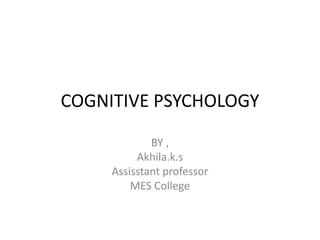
COGNITIVE PSYCHOLOGY INTRO.pptx
- 1. COGNITIVE PSYCHOLOGY BY , Akhila.k.s Assisstant professor MES College
- 2. WHAT IS COGNITIVE PSYCHOLOGY ? Cognitive psychology is the scientific study of the thinking mind and is concerned with , How we attend to gain information about the world How that information is stored and processed How we solve problems, think and formulate language
- 3. Cognitive psychology involves the total range of Psychological processes from sensation to perception,neuroscience,pattern recognition, Attention, consciouness,learning, memory ,concept formation,thinking,imaging,remembering,language,in telligence,emotions and developmental processes and cut across all the field of behavior.
- 4. THE DOMAINS OF COGNITIVE PSYCHOLOGY Modern cognitive psychology draws theories and techniques from twelve principle areas of research , • Cognitive neuroscience • Perception • Pattern recognition • Attention • Consciousness
- 5. • Memory • Representation of knowledge • Imagery • Language • Developmental psychology • Thinking and concept formation • Human and artificial intelligence
- 6. COGNITION IN THE RENAISSANCE AND BEYOND Renaissance philosophers and theologians seemed generally satisfied that knowledge was located in the brain. During eighteenth century when philosophic psychology was brought to point where scientific psychology could assume a role…
- 7. British empiricists –George Berkely,David Hume , and later James mill and his son John Stuart Mill –suggested that internal representations of three types; direct sensory events faint copies of percepts transformation of these faint copies
- 8. During nineteenth century Psychologists started to break away from philosophy to form a discipline based on empirical results rather than on speculation . Conspicuous as a factor in this emergence was the activity of the early psychologists –gustav fechner ,franz brentano,hermann helmiholtz william wundt etc…
- 9. By the last half of nineteenth century ,theories of the representation of knowledge were clearly dichotomous; there were those ,led by wundt in germany and titchener in the united states ,that empasizhed the structure of mental representation ; and those led by Brentano in Austraila ,that emphasized the processe or acts.
- 10. The early twentieth century The representation of knowledge , as we have used the term ,took a radical return with the advent of twentieth century behaviorism and gestalt psychology. The behaviorist view of human and animal psychology were cast in a framework of stimulus response psychology , and the gestalt theorists built elaborate conceptualizations of internal representation within the context of isomorphism.
- 11. Cognitive psychology – As it is today In the 1950 s interest again began to focus on attention ,memory ,pattern recognition, semantic organization,images,thinking, language process and even consciousness. As cognitive psychology became established with even greater clarity ,it was plain that this was a brand of psychology different from that in vogue during the 1930s and 1940s.
- 12. Among the most important forces accounting for this neocognitive revolution were the following; • The failure of behaviorism • The emergence of communication theory • Modern linguistics • Memory research • Computer science and technological advances • Cognitive development
- 13. MODELS OF COGNITIVE PSYCHOLOGY The Information-Processing Approach The information-processing approach dominated cognitive psychology in the 1960s and 1970s and remains strong and influential today (Atkinson & Shiffrin, 1968). As its name implies, the information- processing approach draws an analogy between human cognition and computerized processing of information. Central to the information-processing approach is the idea that cognition can be thought of as information (what we see, hear, read about, think about) passing through a system (us or, more specifically, our minds)
- 14. The connectionist approach Early in the 1980s, researchers from a variety of disciplines began to explore alternatives to the information-processing approach that could explain cognition. The framework they established is known as connectionism (sometimes also called parallel-distributed processing, or PDP). Its name is derived from models depicting cognition as a network of connections among simple (and usually numerous) processing units (McClelland, 1988). Because these units are sometimes compared to neurons, the cells that transmit electrical impulses and underlie all sensation and muscle movement, connectionist models are sometimes called neural networks.
- 15. Each unit is connected to other units in a large network. Each unit has some level of activation at any particular moment in time. The exact level of activation depends on the input to that unit from both the environment and other units to which it is connected. Connections between two units have weights, which can be positive or negative. A positively weighted connection causes one unit to excite, or raise the level of activation of units to which it is connected; a negatively weighted connection has the opposite effect, inhibiting or lowering the activation of connected units.
- 16. The evolutionary approch • Evolutionary psychologist Leda Cosmides (1989) notes that the environments our ancestors experienced were not simply physical, but ecological and social as well. • Cosmides and Tooby (2002) argue that people have “a large and heterogeneous set of evolved, reliably developing, dedicated problem-solving programs, each of which is specialized to solve a particular domain or class of adaptive problems (e.g., grammar acquisition, mate acquisition, food aversion, way finding
- 17. The ecological approach • The ecological paradigm stresses the ways in which the environment and the context shape the way cognitive processing occurs.